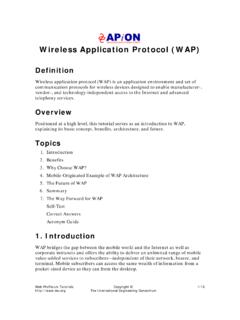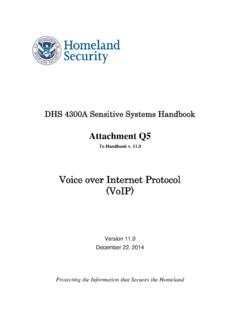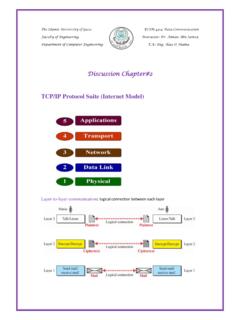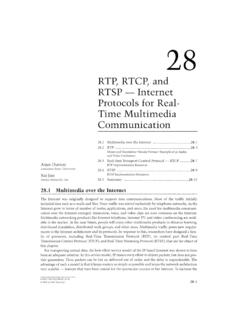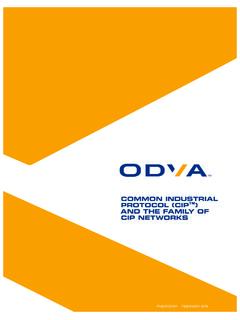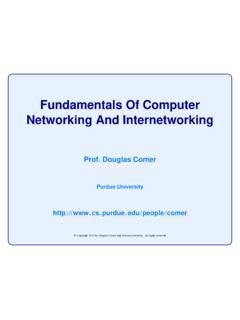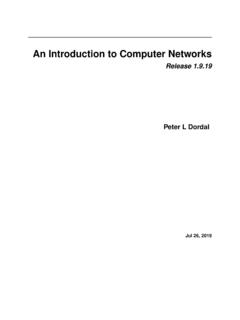Transcription of Data Communication and Computer Network - …
1 data Communication and Computer Network data Communication and Computer Network i About the Tutorial This tutorial gives very good understanding on data Communication and Computer Networks. After completing this tutorial, you will find yourself at a moderate level of expertise in knowing DCN, from where you can take yourself to next levels. Audience This tutorial is prepared for the beginners to help them understand data Communication and Computer Networks. Prerequisites Before proceeding with this tutorial, you need a basic understanding of Computer .
2 You should know the basics of input and output devices, primary and secondary memory, and operating system. Disclaimer & Copyright Copyright 2014 by Tutorials Point (I) Pvt. Ltd. All the content and graphics published in this e-book are the property of Tutorials Point (I) Pvt. Ltd. The user of this e-book is prohibited to reuse, retain, copy, distribute or republish any contents or a part of contents of this e-book in any manner without written consent of the publisher. We strive to update the contents of our website and tutorials as timely and as precisely as possible, however, the contents may contain inaccuracies or errors.
3 Tutorials Point (I) Pvt. Ltd. provides no guarantee regarding the accuracy, timeliness or completeness of our website or its contents including this tutorial. If you discover any errors on our website or in this tutorial, please notify us at data Communication and Computer Network ii Contents About the Tutorial .. i Audience .. i Prerequisites .. i Disclaimer & Copyright .. i Contents .. ii 1. OVERVIEW .. 1 Classification of Computer Networks .. 1 Geographical Span .. 1 Inter-Connectivity .. 1 Administration .. 2 Network Architecture .. 2 Network Applications .. 2 2. TYPES OF Computer NETWORKS.
4 3 Personal Area Network .. 3 Local Area 3 Metropolitan Area Network .. 4 Wide Area Network .. 5 6 3. Network LAN TECHNOLOGIES .. 8 Ethernet .. 8 Fast-Ethernet .. 8 Giga-Ethernet .. 8 Virtual 9 4. Computer Network TOPOLOGIES .. 10 Point-to-Point .. 10 Bus Topology .. 10 data Communication and Computer Network iii Star Topology .. 11 Ring Topology .. 12 Mesh Topology .. 13 Tree Topology .. 14 Daisy Chain .. 15 Hybrid 15 5. Computer Network MODEL .. 17 Layered 17 OSI Model .. 18 internet Model .. 19 6. Computer Network SECURITY .. 20 Secret Key Encryption .. 21 Public Key Encryption.
5 21 Message Digest .. 21 7. PHYSICAL LAYER INTRODUCTION .. 22 Signals .. 22 Transmission Impairment .. 22 Transmission Media .. 23 Channel Capacity .. 23 24 Switching .. 24 8. DIGITAL TRANSMISSION .. 25 Digital-to-Digital Conversion .. 25 Line Coding .. 25 Unipolar Encoding .. 26 Polar Encoding .. 26 Bipolar Encoding .. 28 data Communication and Computer Network iv Block Coding .. 28 Analog-to-Digital Conversion .. 29 Sampling .. 29 Quantization .. 29 Encoding .. 30 Transmission Modes .. 30 9. ANALOG TRANSMISSION .. 32 Digital-to-Analog Conversion .. 32 Analog-to-Analog Conversion.
6 34 10. TRANSMISSION 38 Magnetic Media .. 38 Twisted Pair Cable .. 38 Coaxial Cable .. 39 Power Lines .. 40 Fiber Optics .. 40 11. WIRELESS TRANSMISSION .. 42 Radio Transmission .. 42 Microwave Transmission .. 43 Infrared Transmission .. 44 Light Transmission .. 44 12. MULTIPLEXING .. 46 Frequency Division Multiplexing .. 46 Time Division Multiplexing .. 46 Wavelength Division Multiplexing .. 47 Code Division Multiplexing .. 48 13. SWITCHING .. 49 Circuit Switching .. 49 data Communication and Computer Network v Message 50 Packet Switching .. 51 14. data LINK LAYER INTRODUCTION.
7 53 Functionality of data -link Layer .. 53 15. ERROR DETECTION AND CORRECTION .. 55 Types of Errors .. 55 Error Detection .. 56 Error Correction .. 57 16. data LINK CONTROL AND PROTOCOLS .. 59 Flow Control .. 59 Error Control .. 60 17. Network LAYER INTRODUCTION .. 64 Layer-3 Functionalities .. 64 Network Layer Features .. 64 18. Network ADDRESSING .. 65 19. Network ROUTING .. 67 Unicast routing .. 67 Broadcast routing .. 68 Multicast 69 Anycast Routing .. 69 Unicast Routing Protocols .. 70 Multicast Routing Protocols .. 70 Routing Algorithms .. 71 20. INTERNETWORKING .. 72 Tunneling.
8 72 Packet Fragmentation .. 73 data Communication and Computer Network vi 21. Network LAYER PROTOCOLS .. 75 Address Resolution protocol (ARP) .. 75 internet Control Message protocol (ICMP) .. 76 internet protocol Version 4 (IPv4) .. 76 internet protocol Version 6 (IPv6) .. 77 22. TRANSPORT LAYER INTRODUCTION .. 78 Functions .. 78 End-to-End Communication .. 78 23. TRANSMISSION CONTROL protocol .. 80 Features .. 80 Header .. 80 Addressing .. 82 Connection 82 Bandwidth Management .. 83 Error Control and Flow Control .. 84 84 Congestion Control .. 84 Timer Management .. 85 Crash Recovery.
9 85 24. USER DATAGRAM protocol .. 87 Requirement of UDP .. 87 Features .. 87 UDP Header .. 87 UDP application .. 88 25. APPLICATION LAYER INTRODUCTION .. 89 26. CLIENT-SERVER MODEL .. 91 data Communication and Computer Network vii Communication .. 92 27. APPLICATION PROTOCOLS .. 94 Domain Name System .. 94 Simple Mail Transfer protocol .. 94 File Transfer protocol .. 94 Post Office protocol (POP) .. 95 Hyper Text Transfer protocol (HTTP) .. 95 28. Network SERVICES .. 96 Directory Services .. 96 File Services .. 96 Communication Services .. 97 Application Services .. 97 data Communication and Computer Network 1 A system of interconnected computers and computerized peripherals such as printers is called Computer Network .
10 This interconnection among computers facilitates information sharing among them. Computers may connect to each other by either wired or wireless media. Classification of Computer Networks Computer networks are classified based on various factors. They include: Geographical span Inter-connectivity Administration Architecture Geographical Span Geographically a Network can be seen in one of the following categories: It may be spanned across your table, among Bluetooth enabled devices, Ranging not more than few meters. It may be spanned across a whole building, including intermediate devices to connect all floors.










